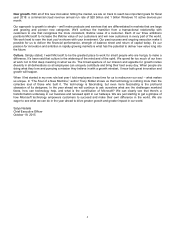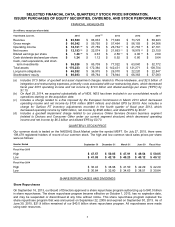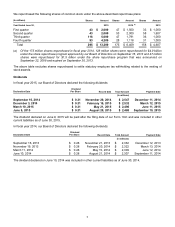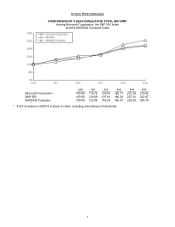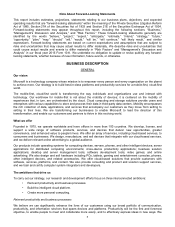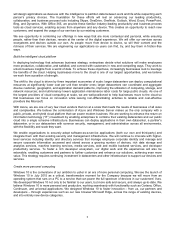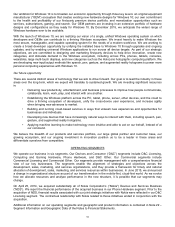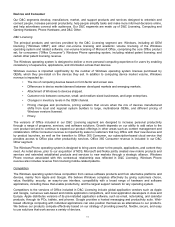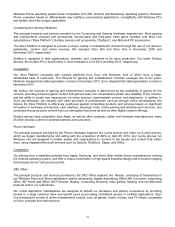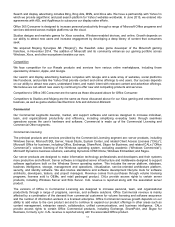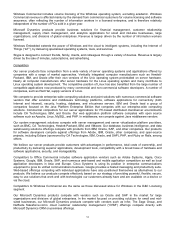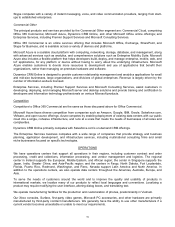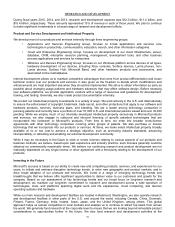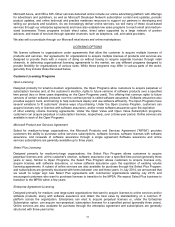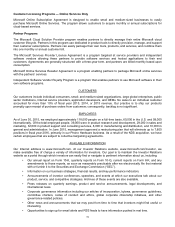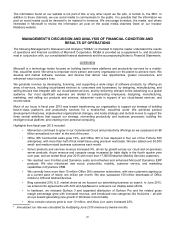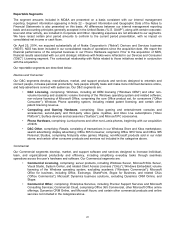Microsoft 2015 Annual Report Download - page 15
Download and view the complete annual report
Please find page 15 of the 2015 Microsoft annual report below. You can navigate through the pages in the report by either clicking on the pages listed below, or by using the keyword search tool below to find specific information within the annual report.
14
Windows Commercial includes volume licensing of the Windows operating system, excluding academic. Windows
Commercial revenue is affected mainly by the demand from commercial customers for volume licensing and software
assurance, often reflecting the number of information workers in a licensed enterprise, and is therefore relatively
independent of the number of PCs sold in a given year.
Microsoft Dynamics products provide business solutions for financial management, customer relationship
management, supply chain management, and analytics applications for small and mid-size businesses, large
organizations, and divisions of global enterprises. Revenue is largely driven by the number of information workers
licensed.
Windows Embedded extends the power of Windows and the cloud to intelligent systems, including the Internet of
Things (“IoT”), by delivering specialized operating systems, tools, and services.
Skype is designed to connect friends, family, clients, and colleagues through a variety of devices. Revenue is largely
driven by the sale of minutes, subscriptions, and advertising.
Competition
Our server products face competition from a wide variety of server operating systems and applications offered by
companies with a range of market approaches. Vertically integrated computer manufacturers such as Hewlett-
Packard, IBM, and Oracle offer their own versions of the Unix operating system preinstalled on server hardware.
Nearly all computer manufacturers offer server hardware for the Linux operating system and many contribute to
Linux operating system development. The competitive position of Linux has also benefited from the large number of
compatible applications now produced by many commercial and non-commercial software developers. A number of
companies, such as Red Hat, supply versions of Linux.
We compete to provide enterprise-wide computing solutions and point solutions with numerous commercial software
vendors that offer solutions and middleware technology platforms, software applications for connectivity (both
Internet and intranet), security, hosting, database, and e-business servers. IBM and Oracle lead a group of
companies focused on the Java Platform Enterprise Edition that competes with our enterprise-wide computing
solutions. Commercial competitors for our server applications for PC-based distributed client/server environments
include CA Technologies, IBM, and Oracle. Our web application platform software competes with open source
software such as Apache, Linux, MySQL, and PHP. In middleware, we compete against Java middleware vendors.
Our system management solutions compete with server management and server virtualization platform providers,
such as BMC, CA Technologies, Hewlett-Packard, IBM, and VMware. Our database, business intelligence, and data
warehousing solutions offerings compete with products from IBM, Oracle, SAP, and other companies. Our products
for software developers compete against offerings from Adobe, IBM, Oracle, other companies, and open-source
projects, including Eclipse (sponsored by CA Technologies, IBM, Oracle, and SAP), PHP, and Ruby on Rails, among
others.
We believe our server products provide customers with advantages in performance, total costs of ownership, and
productivity by delivering superior applications, development tools, compatibility with a broad base of hardware and
software applications, security, and manageability.
Competitors to Office Commercial includes software application vendors such as Adobe Systems, Apple, Cisco
Systems, Google, IBM, Oracle, SAP, and numerous web-based and mobile application competitors as well as local
application developers in Asia and Europe. Cisco Systems is using its position in enterprise communications
equipment to grow its unified communications business. Google provides a hosted messaging and productivity suite.
Web-based offerings competing with individual applications have also positioned themselves as alternatives to our
products. We believe our products compete effectively based on our strategy of providing powerful, flexible, secure,
easy to use solutions that work well with technologies our customers already have and are available on a device or
via the cloud.
Competitors to Windows Commercial are the same as those discussed above for Windows in the D&C Licensing
segment.
Our Microsoft Dynamics products compete with vendors such as Oracle and SAP in the market for large
organizations and divisions of global enterprises. In the market focused on providing solutions for small and mid-
sized businesses, our Microsoft Dynamics products compete with vendors such as Infor, The Sage Group, and
NetSuite. Salesforce.com’s cloud customer relationship management (“CRM”) offerings compete directly with
Microsoft Dynamics CRM on-premises offerings.


